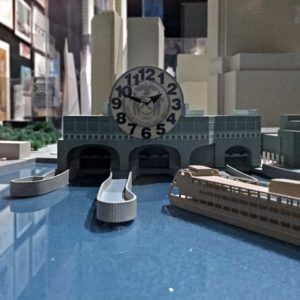A look at the Queens Museum of Art’s exhibition of unbuilt architectural concepts.
Fun and fascinating, Never Built New York is a small exhibition on a big topic, featuring roughly 100 structures that aspired to change the skyline but never saw the light of day. The projects on view range from residential to commercial structures, from urban planning to entertainment, from breathtaking to ridiculous.
The bulk of the exhibition is tucked away in an awkwardly-shaped gallery behind the museum’s iconic Panorama. The walls are overstuffed with sketches and renderings, and a few well-placed models provide dimensionality. The gallery’s layout mirrors the shape of Manhattan and provides a point of orientation, starting downtown with Venturi, Scott Brown’s Whitehall Ferry Terminal and heading northward toward Buckminster Fuller’s Skyrise for Harlem. It might have been useful to have maps on hand to help visualize how the projects would have fit into the city we know.

The narrow space, with its joyless flat black walls, invites claustrophobia, though the absence of texts kept visitors moving quickly enough to avoid crowding. Visitors were provided with gallery guides in lieu of labels, featuring a spare sentence or two about each of the works; a few explained why the projects never came to be, but many left this a mystery.
This gallery leads directly into the museum’s Panorama of the City of New York, the exquisitely detailed (and maintained) scale model of the five boroughs. Here’s where the exhibition pulls off its one true moment of spectacle: placed across the map are a selection of scale models representing the unbuilt projects, illuminated translucent structures whose glow provides a vision of the city that could have been. The enormity of the panorama makes it impossible to get close up to these structures, but they clearly communicate the impact these projects, many of them immense, might have had on the skyline.
At the top of the Panorama’s ramp, visitors can access a virtual reality tour of five of the projects, which shows 360-degree views the unbuilt structures placed within their current-day contexts. It’s a nice effect, and simply presented on mobile VR devices, but I wished I could truly explore the buildings in 3D from multiple perspectives. Unfortunately, it felt like an afterthought, not least because it was difficult to locate, even for a visitor like me who was actively looking for it. Fortunately, the content is available free of charge for both iOS and Android devices.
The exhibition’s third act takes place in the spacious Skylight Gallery, which features projects originally intended for Flushing Meadows Corona Park. This includes a fascinating Unisphere alternative designed by Paul Rudolph, as well as renovation concepts for the Queens Museum itself. In the gallery’s center is a representation of Eliot Noyes’ unbuilt Westinghouse Pavilion, designed for the 1964-65 New York World’s Fair. But it’s not just a model, it’s…
…a bouncy house. I’m seriously not sure what to make of this. It’s fun and silly, and it provides the exhibition with an iconic 3D photo op. But it has little to do with the pavilion, or the exhibit, and its blobby form is a crude approximation of Noyes’ elegant design (shown at top of page). It was not in operation on the day of my visit… maybe kids like it?

The exhibition has an unusual history; it’s a spin-off of 2012’s Never Built Los Angeles exhibition. Both were partly funded via Kickstarter (the bouncy house, ironically, was a “stretch goal”). The LA version, by Clive Wilkinson Architects, appears to have had a higher budget and a more engaging design.
If you have an interest in the history of modern architecture or world’s fairs, you’ll find plenty to pique your interest; the models and renderings are almost uniformly beautiful. But the exhibition’s stated rationale (from its Kickstarter page) suggests more:
What lessons can we learn from forgotten or neglected ideas? Through Never Built New York, the Queens Museum will not only exhibit many daring designs that were never realized, but also encourage discourse around how some of the most pressing issues of our time — ecological sustainability, population displacement, and economic inequity — are inextricably linked to our built environment. With the support of the Kickstarter community, we will demonstrate how the architectural insights of the past can help us plan for a stronger future.
Naah. There’s really no interpretation to speak of here that even begins to address any of these issues. The catalog includes an insightful introduction by the curators, Gregg Goldin and Sam Lubell, but the geographic, encyclopedic arrangement of the exhibition doesn’t illuminate connections, or really raise questions of “why.” It’s a lost opportunity, one that might have leveraged these beautiful concepts to engage visitors with the challenges of envisioning the city’s next century.





